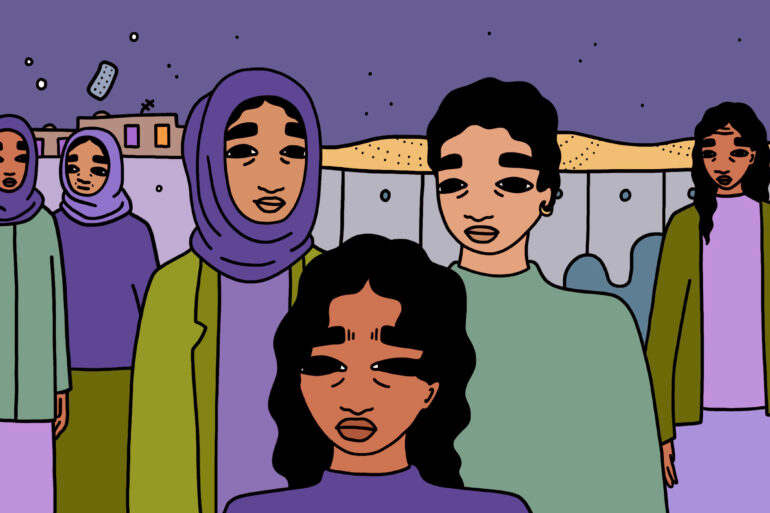The Free Tibet movement was once a popular culture phenomenon. At its peak in the 90s, Tibetan Freedom Concerts were held in support of it across the United States, Europe and Asia with backing from musicians and celebrities like the Beastie Boys, Blur and Richard Gere. People in the crowd and on the streets wore t-shirts calling for a free Tibet and nightclubs danced to chart hits like Banco de Gaia’s “Last train to Lhasa.”
Today the movement is less high profile but still campaigns and pushes for an end to China’s human rights abuses in the once independent Himalayan country of Tibet.
Tibet has a complex history which is intertwined with that of China through dynasties and empires but they are a separate people and culture. It was an independent country for the first half of the twentieth century until the People’s Republic of China invaded and occupied it in 1950, eventually causing the Dalai Lama to flee. Tibetans, as well as other peoples under Chinese rule such as the predominantly Muslim Uyghurs, still suffer human rights abuses, including restrictions on speech, religion and possible imprisonment and torture for opposing Beijing.
The Free Tibet movement began between 1987 and 1989 and was formed in response to protests in Tibet at the time which were violently suppressed by the Chinese government. Some claim hundreds of people were killed or injured during the period including Tibetans and Chinese soldiers. A Dutch tourist called Christa Meindersma was also shot in the arm by Chinese forces. Tibet was more open to foreign travellers and journalists then which meant stories and photographs of the crackdown came out of the country. The events made headlines in the western media and sparked public interest, which was boosted by advocacy from the Dalai Lama.
Some of the travellers caught in the violence would later play influential roles in the free Tibet movement, publishing famous photographs of the events when they returned home or working with Tibet support groups which became the basis of the movement. A few foreigners in Lhasa at the time like John Ackerley, Blake Kerr, Nicholas Howen and Christa Meindersma met in a hotel room and decided they would bring evidence out of the country.
“There was this kind of… Greenpeace or Quaker philosophy of bearing witness. This sense of taking responsibility for what they had seen which carried people back to their home countries and meant that they became involved in setting up Tibet support groups,” said Alison Reynolds, a former director of the London based group, Free Tibet.
Free Tibet in London was founded in 1987, originally under the name Tibet Support Group UK, and became a core pillar of the growing free Tibet movement. Sue Byrne who had been working on Tibet before it was propelled into public consciousness by the protests helped found it. She met the Dalai Lama in a London airport hotel in 1987 and he encouraged her to carry on with her work.
“He was introduced to me and he grasped my hand and he said something like ‘please continue, please continue.’ I had my instructions, so to speak. Not that I see it as broadly as that,” Byrne said.
Free Tibet became the largest group in Britain while others like the International Campaign for Tibet took the lead in the US. Many of the founders wanted to create powerful voices in the West which would draw attention to the human rights abuses that some travellers had seen in Lhasa first hand.
Momentum built and during the 90s Tibet became a high profile issue for celebrities, film stars and the music industry. There were books, films and documentaries about the country and Beastie Boys member Adam Yauch helped organise the Tibetan Freedom Concerts which happened across the United States, Asia and Europe. This publicity was combined with less high profile, but arguably even more decisive efforts of Tibetans, Tibet campaigners and Tibet supporters around the world.
“Tibet was a sort of celebrity music industry issue… I was at the Washington D.C. concert where Brad Pitt met Jennifer Anniston, famously,” Reynolds said. “It was a period of quite significant campaign successes and early political prisoner releases. The high profile of the concerts, it did definitely feel like a special time. But then ten years later when the uprisings were happening and the Olympics was happening it felt very much the same… the scale of activity was just extraordinary.”
Reynolds believes Free Tibet’s most important moments to date have been the freedom concerts of the 90s, the early release of political prisoners and its campaign around the 2008 Beijing Olympics which put China under international pressure and coincided with a national uprising in Tibet. This “tarnished” Beijing’s reputation, Reynolds said.
Today Free Tibet and the wider movement still advocate for Tibetans and draw attention to serious human rights violations which continue in the country under Chinese rule.
Earlier this year Free Tibet reported that the Chinese government has been ordering Tibetans to remove pictures of the Dalai Lama from their homes and replace them with images of Xi Jinping and other CCP leaders. Tibetans living in poverty have also been forced to take exams which test knowledge of China in return for government aid. Meanwhile Free Tibet continues to campaign for political prisoners like Tashi Wangchuk, who China put behind bars for his attempts to protect the right of Tibetans to learn and speak their native language.
The current director of Free Tibet, Eleanor Byrne-Rosengren, said she took over as head of the organisation in 2013 partly because she feels a personal link to the issues in the country.
She said, “I’d grown up seeing news and documentaries about Tibet and the occupation. Then, when the Panchen Lama was kidnapped I was living in north-east India in an area with a strong Tibetan community. I felt physically connected to what was happening. When I got back to the UK I saw campaign leaflets about the Panchen Lama and joined Free Tibet as a supporter. I’ve been involved ever since.”
She leads the organisation at a time when the power, influence and assertiveness of the Chinese government has hit new heights. Nevertheless, Free Tibet and its supporters have shown defiance. They helped organise against Chinese leader Xi Jinping’s 2015 visit to the UK, creating a vocal presence despite being outnumbered by organised Chinese counter-protesters. They confronted Xi in the streets of London and forced his handlers to scramble him into a building under a tarpaulin cover. The visit should have been a triumphant moment for Xi, but the Tibet movement guided the media discourse, raising questions over whether the UK was “kow-towing” to China.
The movement has suffered increasing challenges too, and Byrne-Rosengren said the biggest is the fact that Tibet is still occupied by an increasingly powerful and influential China. This can make it harder to push other governments to act even when they know they should.
There are also other challenges like an ageing support base for the Tibetan cause, alternative human rights issues which have consumed global attention and Brexit, which Byrne-Rosengren said could mean UK politicians will be less willing to confront China on human rights. Meanwhile, Tibetans, along with Uyghurs, are seeing their culture and way of life systematically eradicated.
Byrne-Rosengren hopes Tibetans living under Chinese rule can resist full assimilation and preserve their culture long enough for the political climate in China to change internally which she believes will happen sooner or later.
Subscribe to shado's weekly newsletter
Exclusive event news, job and creative opportunities, first access to tickets and – just in case you missed them – our picks of the week, from inside shado and out.

She said tough times lie ahead for the Free Tibet movement because of the current political climate in the UK and beyond, but she added that there is hope for the cause.
On 19 December last year, the US made the Reciprocal Access for Tibet Act into law. It aims to push China into opening Tibet to US journalists, diplomats and other officials by barring Chinese figures who are involved in blocking access to Tibet from entering the US. Byrne-Rosengren highlighted this as a positive move from the United States.
Byrne-Rosengren said the key for the free Tibet movement moving forward is to “look for new allies, look for new angles and just keep pushing, because one day something will snap and that change will come.”
For the time being, hope lies in the crucial victories that Free Tibet and the wider Tibet movement continue to win. In the past twelve months Premier League football team, Liverpool scrapped a controversial sponsorship deal with a bottled water company that exploits Tibet’s natural resources, while in the US the Reciprocal Access to Tibet Act passed. Most recently, a coalition of Tibetan, Uyghur, Chinese and consumer rights campaigners convinced internet giant Google to drop its controversial China search engine called Project Dragonfly which would have censored search terms like “Tibet” and “human rights” for Google users in China.
“These victories show what can be achieved when the Tibet movement works together”, Byrne-Rosengren said. Adding, “Tibet is not in the news as much as it was in the past, but our work has demonstrated that when people learn about Tibet, they do care and they do want to help. This support helps us to win our campaigns and keeps the movement strong, while the victories remind us that a free Tibet may one day be possible”.















